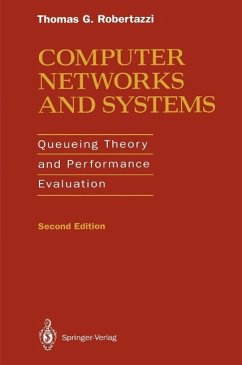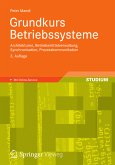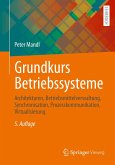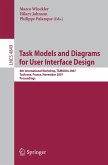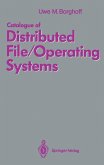Thomas G. Robertazzi
Computer Networks and Systems (eBook, PDF)
Queueing Theory and Performance Evaluation
62,95 €
62,95 €
inkl. MwSt.
Sofort per Download lieferbar

31 °P sammeln
62,95 €
Als Download kaufen

62,95 €
inkl. MwSt.
Sofort per Download lieferbar

31 °P sammeln
Jetzt verschenken
Alle Infos zum eBook verschenken
62,95 €
inkl. MwSt.
Sofort per Download lieferbar
Alle Infos zum eBook verschenken

31 °P sammeln
Thomas G. Robertazzi
Computer Networks and Systems (eBook, PDF)
Queueing Theory and Performance Evaluation
- Format: PDF
- Merkliste
- Auf die Merkliste
- Bewerten Bewerten
- Teilen
- Produkt teilen
- Produkterinnerung
- Produkterinnerung

Bitte loggen Sie sich zunächst in Ihr Kundenkonto ein oder registrieren Sie sich bei
bücher.de, um das eBook-Abo tolino select nutzen zu können.
Hier können Sie sich einloggen
Hier können Sie sich einloggen
Sie sind bereits eingeloggt. Klicken Sie auf 2. tolino select Abo, um fortzufahren.

Bitte loggen Sie sich zunächst in Ihr Kundenkonto ein oder registrieren Sie sich bei bücher.de, um das eBook-Abo tolino select nutzen zu können.
Die Funktionsfähigkeit komplizierter Systeme, wie z.B. eines Telefonnetzes, voraussagen zu können ohne es tatsächlich aufbauen zu müssen, hat sich zu einem wesentlichen Teil der Ingenieurarbeit entwickelt. Der vorliegende Text, als einführender Kurs in die Performance Evaluation gedacht, behandelt alle Aspekte der Warteschlangentheorie.
- Geräte: PC
- ohne Kopierschutz
- eBook Hilfe
- Größe: 26.08MB
Andere Kunden interessierten sich auch für
![Grundkurs Betriebssysteme (eBook, PDF) Grundkurs Betriebssysteme (eBook, PDF)]() Peter MandlGrundkurs Betriebssysteme (eBook, PDF)20,67 €
Peter MandlGrundkurs Betriebssysteme (eBook, PDF)20,67 €![Grundkurs Betriebssysteme (eBook, PDF) Grundkurs Betriebssysteme (eBook, PDF)]() Peter MandlGrundkurs Betriebssysteme (eBook, PDF)22,99 €
Peter MandlGrundkurs Betriebssysteme (eBook, PDF)22,99 €![Grundkurs Betriebssysteme (eBook, PDF) Grundkurs Betriebssysteme (eBook, PDF)]() Peter MandlGrundkurs Betriebssysteme (eBook, PDF)29,99 €
Peter MandlGrundkurs Betriebssysteme (eBook, PDF)29,99 €![Task Models and Diagrams for User Interface Design (eBook, PDF) Task Models and Diagrams for User Interface Design (eBook, PDF)]() Task Models and Diagrams for User Interface Design (eBook, PDF)40,95 €
Task Models and Diagrams for User Interface Design (eBook, PDF)40,95 €![Grundkurs Betriebssysteme (eBook, PDF) Grundkurs Betriebssysteme (eBook, PDF)]() Peter MandlGrundkurs Betriebssysteme (eBook, PDF)22,99 €
Peter MandlGrundkurs Betriebssysteme (eBook, PDF)22,99 €![Android (eBook, PDF) Android (eBook, PDF)]() Dirk LouisAndroid (eBook, PDF)25,99 €
Dirk LouisAndroid (eBook, PDF)25,99 €![Catalogue of Distributed File/Operating Systems (eBook, PDF) Catalogue of Distributed File/Operating Systems (eBook, PDF)]() Uwe M. BorghoffCatalogue of Distributed File/Operating Systems (eBook, PDF)40,95 €
Uwe M. BorghoffCatalogue of Distributed File/Operating Systems (eBook, PDF)40,95 €-
-
-
Die Funktionsfähigkeit komplizierter Systeme, wie z.B. eines Telefonnetzes, voraussagen zu können ohne es tatsächlich aufbauen zu müssen, hat sich zu einem wesentlichen Teil der Ingenieurarbeit entwickelt. Der vorliegende Text, als einführender Kurs in die Performance Evaluation gedacht, behandelt alle Aspekte der Warteschlangentheorie.
Dieser Download kann aus rechtlichen Gründen nur mit Rechnungsadresse in A, B, BG, CY, CZ, D, DK, EW, E, FIN, F, GR, HR, H, IRL, I, LT, L, LR, M, NL, PL, P, R, S, SLO, SK ausgeliefert werden.
Produktdetails
- Produktdetails
- Verlag: Springer US
- Erscheinungstermin: 6. Dezember 2012
- Englisch
- ISBN-13: 9781468404739
- Artikelnr.: 44182487
- Verlag: Springer US
- Erscheinungstermin: 6. Dezember 2012
- Englisch
- ISBN-13: 9781468404739
- Artikelnr.: 44182487
- Herstellerkennzeichnung Die Herstellerinformationen sind derzeit nicht verfügbar.
1: The Queueing Paradigm.- 1.1 Introduction.- 1.2 Queueing Theory.- 1.3 Queueing Models.- 1.4 Case Study I: Performance Model of a Distributed File Service By W.G. Nichols and J.S. Emer.- 1.5 Case Study II: Single-bus Multiprocessor Modeling By B.L. Bodnar and A.C. Liu.- 1.6 Case Study III: TeraNet, A Lightwave Network.- 1.7 Case Study IV: Performance Model of a Shared Medium Packet Switch By R. Guerin.- 2: Single Queueing Systems.- 2.1 Introduction.- 2.2 The M/M/1 Queueing System.- 2.3 Little's Law.- 2.4 Reversibility and Burke's Theorem.- 2.5 The State Dependent M/M/1 Queueing System.- 2.6 The M/M/1/N Queueing System: The Finite Buffer Case.- 2.7 The M/M/? Queueing System: Infinite Number of Servers.- 2.8 The M/M/m Queueing System: m Parallel Servers with a Queue.- 2.9 The M/M/m/m Queue: A Loss System.- 2.10 Central Server CPU Model.- 2.11 Transient Solution of the M/M/1/? Queueing System.- 2.12 The M/G/1 Queueing System.- 2.13 Priority Systems for Multiclass Traffic.- To Look Further.- Problems.- 3: Networks of Queues.- 3.1 Introduction.- 3.2 The Product Form Solution.- 3.3 Algebraic Topological Interpretation of the Product Form Solution.- 3.4 Recursive Solution of Nonproduct Form Networks.- 3.5 Queueing Networks with Negative Customers.- To Look Further.- Problems.- 4: Numerical Solution of Models.- 4.1 Introduction.- 4.2 Closed Queueing Networks: Convolution Algorithm.- 4.3 Mean Value Analysis.- 4.4 PANACEA: Approach for Large Markovian Queueing Networks.- 4.5 Norton's Equivalent for Queueing Networks.- 4.6 Simulation of Communication Networks By J.F. Kurose and H.T. Mouftah.- To Look Further.- Problems.- 5: Stochastic Petri Nets.- 5.1 Introduction.- 5.2 Bus-oriented Multiprocessor Model.- 5.3 Toroidal MPN Lattices.- 5.4 The Dining Philosophers Problem.-5.5 A Station-oriented CSMA/CD Protocol Model.- 5.6 The Alternating Bit Protocol.- 5.7 SPN's without Product Form Solutions.- 5.8 Conclusion.- To Look Further.- Problems.- 6: Discrete Time Queueing Systems.- 6.1 Introduction.- 6.2 Discrete Time Queueing Systems.- 6.3 Discrete Time Arrival Processes.- 6.4 The Geom/Geom/m/N Queueing System.- 6.5 The Geom/Geom/1/N and Geom/Geom/1 Queueing Systems.- 6.6 Case Study I: Queueing on a Space Division Packet Switch.- 6.7 Case Study II: Queueing on a Single-buffered Banyan Network.- 6.8 Case Study III: DQDB Erasure Station Location.- To Look Further.- Problems.- 7: Network Traffic Modeling.- 7.1 Introduction.- 7.2 Continuous Time Models.- 7.3 Discrete Time Models.- 7.4 Solution Methods.- 7.5 Burstiness.- 7.6 Self-Similar Traffic.- To Look Further.- Appendix: Probability Theory Review.- A.1 Probability.- A.2 Densities and Distribution Functions.- A.3 Joint Densities and Distributions.- A.4 Expectations.- A.5 Convolution.- A.6 Combinatorics.- A.7 Some Useful Summations.- A.8 Useful Moment-generating Function Identities.- References.
1: The Queueing Paradigm.- 1.1 Introduction.- 1.2 Queueing Theory.- 1.3 Queueing Models.- 1.4 Case Study I: Performance Model of a Distributed File Service By W.G. Nichols and J.S. Emer.- 1.5 Case Study II: Single-bus Multiprocessor Modeling By B.L. Bodnar and A.C. Liu.- 1.6 Case Study III: TeraNet, A Lightwave Network.- 1.7 Case Study IV: Performance Model of a Shared Medium Packet Switch By R. Guerin.- 2: Single Queueing Systems.- 2.1 Introduction.- 2.2 The M/M/1 Queueing System.- 2.3 Little's Law.- 2.4 Reversibility and Burke's Theorem.- 2.5 The State Dependent M/M/1 Queueing System.- 2.6 The M/M/1/N Queueing System: The Finite Buffer Case.- 2.7 The M/M/? Queueing System: Infinite Number of Servers.- 2.8 The M/M/m Queueing System: m Parallel Servers with a Queue.- 2.9 The M/M/m/m Queue: A Loss System.- 2.10 Central Server CPU Model.- 2.11 Transient Solution of the M/M/1/? Queueing System.- 2.12 The M/G/1 Queueing System.- 2.13 Priority Systems for Multiclass Traffic.- To Look Further.- Problems.- 3: Networks of Queues.- 3.1 Introduction.- 3.2 The Product Form Solution.- 3.3 Algebraic Topological Interpretation of the Product Form Solution.- 3.4 Recursive Solution of Nonproduct Form Networks.- 3.5 Queueing Networks with Negative Customers.- To Look Further.- Problems.- 4: Numerical Solution of Models.- 4.1 Introduction.- 4.2 Closed Queueing Networks: Convolution Algorithm.- 4.3 Mean Value Analysis.- 4.4 PANACEA: Approach for Large Markovian Queueing Networks.- 4.5 Norton's Equivalent for Queueing Networks.- 4.6 Simulation of Communication Networks By J.F. Kurose and H.T. Mouftah.- To Look Further.- Problems.- 5: Stochastic Petri Nets.- 5.1 Introduction.- 5.2 Bus-oriented Multiprocessor Model.- 5.3 Toroidal MPN Lattices.- 5.4 The Dining Philosophers Problem.-5.5 A Station-oriented CSMA/CD Protocol Model.- 5.6 The Alternating Bit Protocol.- 5.7 SPN's without Product Form Solutions.- 5.8 Conclusion.- To Look Further.- Problems.- 6: Discrete Time Queueing Systems.- 6.1 Introduction.- 6.2 Discrete Time Queueing Systems.- 6.3 Discrete Time Arrival Processes.- 6.4 The Geom/Geom/m/N Queueing System.- 6.5 The Geom/Geom/1/N and Geom/Geom/1 Queueing Systems.- 6.6 Case Study I: Queueing on a Space Division Packet Switch.- 6.7 Case Study II: Queueing on a Single-buffered Banyan Network.- 6.8 Case Study III: DQDB Erasure Station Location.- To Look Further.- Problems.- 7: Network Traffic Modeling.- 7.1 Introduction.- 7.2 Continuous Time Models.- 7.3 Discrete Time Models.- 7.4 Solution Methods.- 7.5 Burstiness.- 7.6 Self-Similar Traffic.- To Look Further.- Appendix: Probability Theory Review.- A.1 Probability.- A.2 Densities and Distribution Functions.- A.3 Joint Densities and Distributions.- A.4 Expectations.- A.5 Convolution.- A.6 Combinatorics.- A.7 Some Useful Summations.- A.8 Useful Moment-generating Function Identities.- References.
